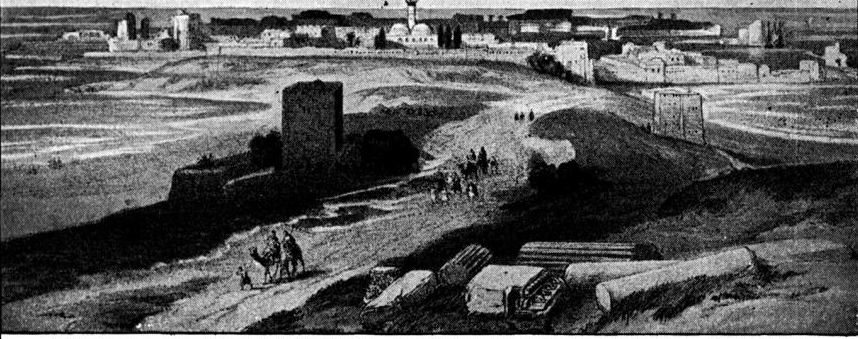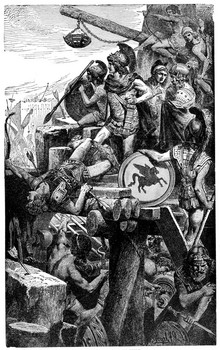With all of the other major settlements in the fold, Alexander now had one major obstacle left to his goal of ruling the entire eastern Mediterranean: Tyre.
At first, the powerful city was a mere footnote to Alexander, who wanted to speed his way to Egypt, the far richer prize. He could have ignored Tyre altogether, but he did not. He sent messengers to the city leaders, offering an agreement under which neither side would attack the other. The Tyrians, thinking themselves safe behind their island walls, scoffed at the proposal, killed the messengers, and dumped them into the Mediterranean. Alexander was furious and vowed to take the city by force.
This city was on an island, one-half mile out to sea, and not in any way connected with the mainland. Alexander had brought no navy with him. How could he possibly hope to conquer Tyre? Well, his legendary determination and impatience took over and carried the day.
With the conquest of Sidon, Alexander suddenly had ships. It wasn't a lot, but it was enough to surround Tyre and prevent reinforcements from reaching the island. But the number of ships wasn't enough, either, to transport Alexander's army to the island. What to do? How do you cross a bridge when none exists? Alexander's answer was to build one.
 In one of the world's most astounding civil engineering achievements, Alexander masterminded the construction of a 200-foot-wide bridge from the mainland to Tyre. His troops built it—and built it well—all the while defending against attacks from Tyre. The beginning of the projects took place in relative safety; but as the bridge got closer to the island, the work got more and more dangerous. Arrows and stones flew constantly from Tyre's archers. They even sailed a burning barge out to the bridge-in-progress. The resulting fire demolished some of the watchtowers on the bridge and killed several of Alexander's men but only hardened his resolve.
In one of the world's most astounding civil engineering achievements, Alexander masterminded the construction of a 200-foot-wide bridge from the mainland to Tyre. His troops built it—and built it well—all the while defending against attacks from Tyre. The beginning of the projects took place in relative safety; but as the bridge got closer to the island, the work got more and more dangerous. Arrows and stones flew constantly from Tyre's archers. They even sailed a burning barge out to the bridge-in-progress. The resulting fire demolished some of the watchtowers on the bridge and killed several of Alexander's men but only hardened his resolve.
When the city was within artillery range, Alexander let fly with stone throwers and light catapults. That effectively put an end to the long-range Tyrian resistance and allowed the  bridge to be completed. Alexander also constructed some naval battering rams, which crushed the walls of Tyre and allowed the Macedonian troops to enter the city. It was a devastating massacre, with the Tyrian death toll topping 7,000. Only 400 of Alexander's men were killed. The king, Azimilik, was spared his life. A full 2,000 men of military age were crucified. The rest of the Tyrians, 30,000 of them, down to the last woman and child, were carted up and taken away as slaves, sold to buyers across the Middle East. Alexander had delivered his message: Defy him and pay the consequences.
bridge to be completed. Alexander also constructed some naval battering rams, which crushed the walls of Tyre and allowed the Macedonian troops to enter the city. It was a devastating massacre, with the Tyrian death toll topping 7,000. Only 400 of Alexander's men were killed. The king, Azimilik, was spared his life. A full 2,000 men of military age were crucified. The rest of the Tyrians, 30,000 of them, down to the last woman and child, were carted up and taken away as slaves, sold to buyers across the Middle East. Alexander had delivered his message: Defy him and pay the consequences.
Next page > In the Footsteps of Gods > Page 1, 2, 3, 4, 5, 6, 7, 8, 9, 10, 11
|




 bridge to be completed. Alexander also constructed some naval battering rams, which crushed the walls of Tyre and allowed the Macedonian troops to enter the city. It was a devastating massacre, with the Tyrian death toll topping 7,000. Only 400 of Alexander's men were killed. The king, Azimilik, was spared his life. A full 2,000 men of military age were crucified. The rest of the Tyrians, 30,000 of them, down to the last woman and child, were carted up and taken away as slaves, sold to buyers across the Middle East. Alexander had delivered his message: Defy him and pay the consequences.
bridge to be completed. Alexander also constructed some naval battering rams, which crushed the walls of Tyre and allowed the Macedonian troops to enter the city. It was a devastating massacre, with the Tyrian death toll topping 7,000. Only 400 of Alexander's men were killed. The king, Azimilik, was spared his life. A full 2,000 men of military age were crucified. The rest of the Tyrians, 30,000 of them, down to the last woman and child, were carted up and taken away as slaves, sold to buyers across the Middle East. Alexander had delivered his message: Defy him and pay the consequences.
